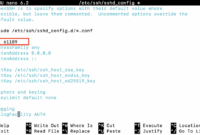
Effectively managing user permissions is crucial for any Ubuntu system administrator. A common and efficient method of handling these permissions is by assigning users to specific groups. Adding a user to a group grants them the permissions and access rights associated with that group, simplifying permission management.
This tutorial provides a step-by-step guide on how to add a user to a group on Ubuntu.
So, let’s begin!
Step 1: Access the Terminal
First, you’ll need to open the terminal. You can achieve this by pressing Ctrl + Alt + T or by searching for “Terminal” in the Ubuntu applications menu.
Step 2: List Existing Groups
Before adding a user, it’s helpful to view the current groups on your system. Use the following command:
cat /etc/group
This command displays a list of all groups defined on your Ubuntu system.
Step 3: Add the User to a Group
To add a user to a group, use the usermod command with the -aG option (which appends the user to the specified group, preserving existing group memberships), followed by the group name and the username:
sudo usermod -aG groupname username
Replace groupname with the actual name of the group you want to add the user to, and username with the username of the user.
Step 4: Confirm Group Membership
After adding the user to the group, it’s important to confirm the user has been correctly added. Use the groups command followed by the username:
groups username
This will display a list of all the groups that the specified user is a member of.
Key Commands
cat /etc/group– Displays a list of all groups on the system.sudo usermod -aG groupname username– Appends a user to a specified group.groups username– Shows all the groups a user belongs to.
FAQ
-
Why is user group management important on Ubuntu?
Managing user groups on Ubuntu helps to control user permissions and access rights efficiently. Grouping users allows administrators to apply specific permissions to all members, streamlining access control and enhancing system security.
-
Can I add a user to multiple groups at the same time?
Yes, you can add a user to multiple groups simultaneously by separating the group names with commas (without spaces) in the `usermod` command. For example: `sudo usermod -aG group1,group2,group3 username`.
-
What is the difference between a primary and secondary group in Ubuntu?
Every user in Ubuntu has a primary group, which is the default group assigned to newly created files and directories. Secondary groups are additional groups the user is a member of. The primary group determines default file ownership, while secondary groups grant extra access and permissions.
-
Do I need to restart the system after adding a user to a group?
No, a full system restart is not required. However, for the user to gain the privileges of the new group, they need to log out and log back in, or start a new session.
-
How do I remove a user from a group?
You can remove a user from a group using the `gpasswd` command or by manually editing the `/etc/group` file. Exercise caution when manually editing system files.
Conclusion
Managing user groups is a vital skill for Ubuntu system administrators, ensuring correct user permissions and system security. Understanding the process of adding users to groups enables efficient access control and improved system security.
Whether you’re working with a dedicated server, VPS, cloud hosting, or shared hosting, these steps are universally applicable for user group management in Ubuntu.
Feel free to leave your comments below!

